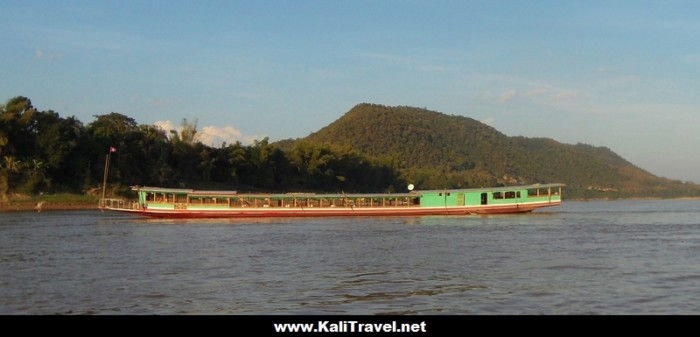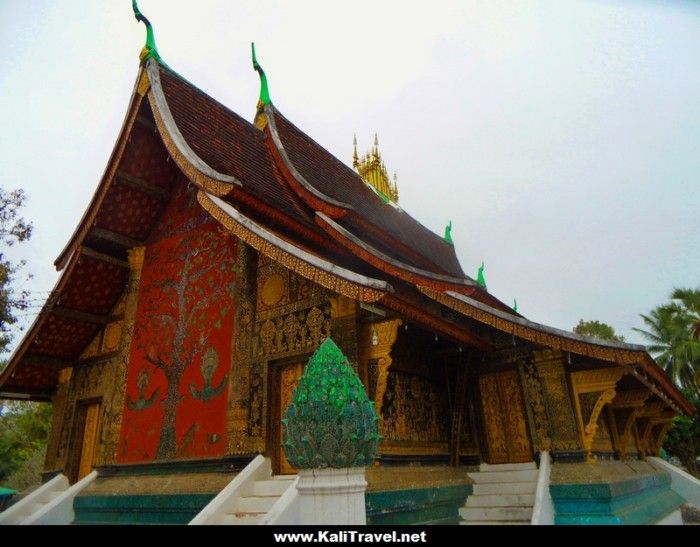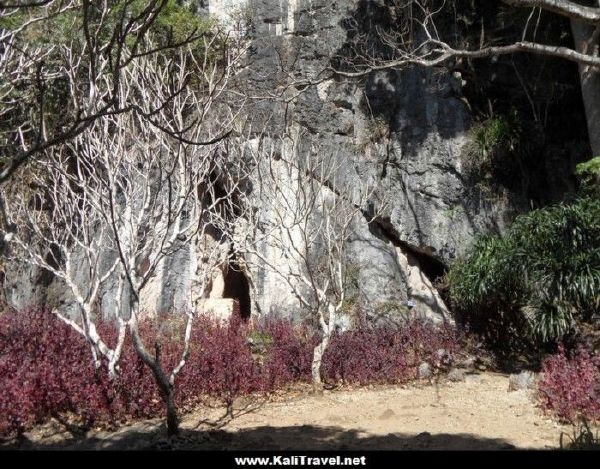A guide to visiting Phonsavan: Plain of Jars and Ban Napia ‘spoon village’ in Northeast Laos.
“Undecided whether to go south, to Vieng Vang and Vientiane or continue to Pakse and the ‘4,000 Islands’ and then hit Cambodia – the usual backpacker drag. Juan wants to go to Halong Bay in North Vietnam, so I check the route from Luang Prabang overland and become intrigued by two towns in Northeast Laos which are virtually unknown – Phonsavan and the Plain of Jars, and Vieng Xai cave city.”
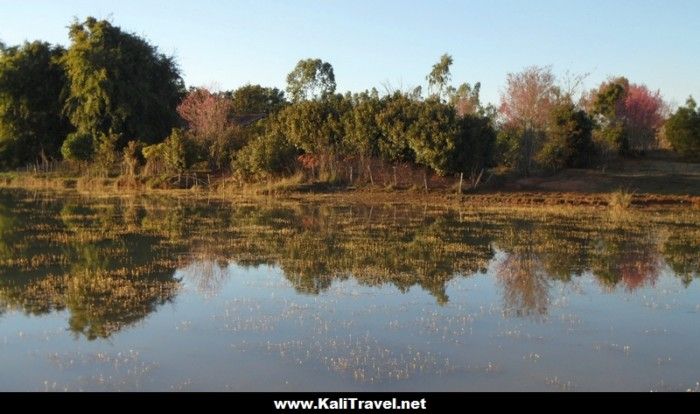
Laos is challenging to get to, a country sandwiched between Myanmar, China, Vietnam, Cambodia and Thailand in the centre of South East Asia, and roads are inadequate and tortuous through mountain terrain. The majority of tourists stay in capital city Vientiane for a day, then fly into Luang Prabang for a tour of the World Heritage Sites before visiting neighbouring countries.
But Laos is worth much more than this, a land to observe from the deck of a 2-day slow boat voyage down the Mekong, and onwards overland to discover out-of-the-way places where you’re practically the only foreign face.
How to see Phonsavan: Plain of Jars and Ban Napia
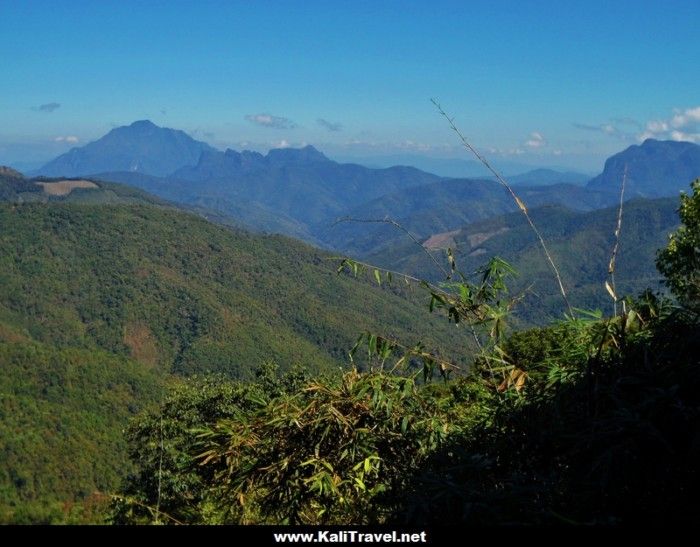
How to Get from Luang Prabang to Plain of Jars
First of all you need to get from Luang Prabang to Phonsavan, the nearest town to Plain Of Jars, by minivan (approx. 7 hours) or regular bus (8 hours). Currently, there are no direct regular passenger flights from Luang Prabang airport to Phonsavan (Xieng Khouang airport). However, an organised or private tour is an option on a charter flight).
Alternatively, you can fly from Luang Prabang to Vientiane (40 mins.), and then a separate flight to Phonsavan – Xieng Khouang (30 mins.). LaoSkyway have a regular flight Luang Prabang (LPQ) to Vientiane (VTE) 4 times a week starting from 20 USD, and Vientiane to Phonsavan (XKH) for a similar price. However, check dates and departure times, as you will no doubt have to spend a night in Vientiane (capital of Laos).
In Phonsavan, hire a scooter, car or bike to reach the Jar Sites, or book an organised tour.
Journey from Luang Prabang to Phonsavan
The direct sleeper bus from Luang Prabang to Hanoi is known as the ‘bus to hell’, the 27+ hour trip notorious; but the journey can be done in 3 legs, a chance to discover rural Laos along the way. The private minibus ticket is not much dearer than getting a standard bus which covers the route from Luang Prabang to Phonsavan – and you get picked up outside your hotel, saving the cost and hassle of getting to the bus station first thing in the morning.
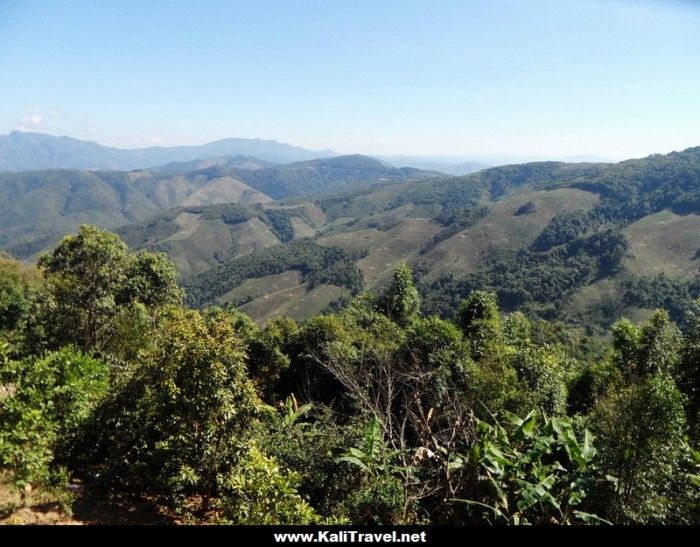
It’s a very winding mountainous road to Phonsavan, like riding a roller-coaster through a convoluted landscape which has been vertically concertinaed by an invisible force. Amazing scenery up and down endless tree-clad mountains, no flat or agricultural land in sight, the occasional community, wooden cabins on stilts right beside the ‘highway’ where families live in desperate poverty.
The minivan hits a hen and then slams on the brakes to miss a baby who has crawled into the middle of the road…a young mother runs out of an open door in horror and scoops him up. The driver is a hero but everyone’s too shocked to speak. Villages are few and far between -some have pampas grass drying on the curb, gathered to make traditional khaem brooms, a home industry to provide some income for those who live in this isolated terrain.
Eventually, there’s a lay-by with some restaurants where the minivans and lorries make a pit-stop, giving drivers and passengers the chance to stretch their legs and eat.
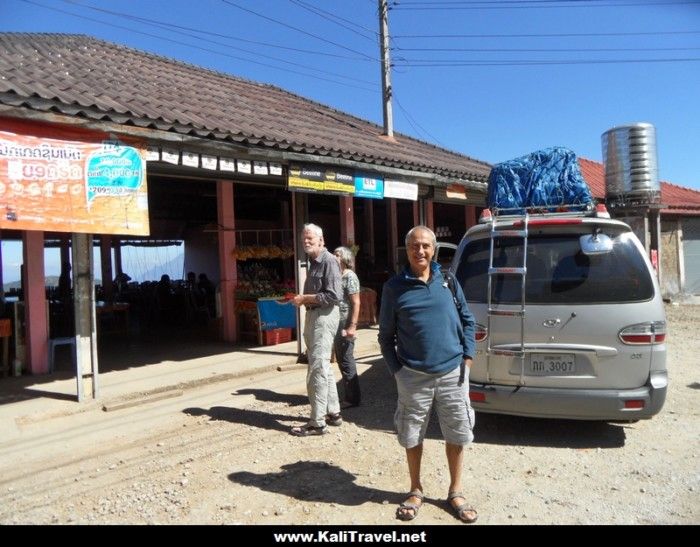
Phonsavan
Some seven hours after starting out from Luang Prabang, we reach Phonsavan completing the first stretch of our adventure through northeast Laos towards Hanoi in Vietnam.
Phonsavan looks surprisingly prosperous after a journey through some pretty remote mountainous terrain. At the mini-bus terminal a guy in a van is collecting a couple from Canada, and he takes us along to the same hostel (the Nice Guesthouse), no charge or commitment. It is a nice place – central, private bathroom, clean and cheap!
The developing town is the capital of Xieng Khouang province – it’s fairly big with plenty of accommodation so booking isn’t essential. The few tourists that do come this way are mostly Asians from China, Thailand and Korea. You can fly into Phonsavan if you are doing things in Vientiane first, as their is a direct flight into small Xieng Khouang airport, however if you’re coming from Luang Prabang there’s no option at the moment.
Late afternoon in Phonsavan and there’s a long boat race on at Nong Nam Ngam, an artificial lake on the edge of town. Juan and I stroll up the busy main street, along a wide avenue past the Regional Government Office and the Friendship Hospital, looking for the annual event – few people speak English but everyone is helpful if you ask, and they’ll call someone else over who does comprehend to direct you on your way. The rowing event is just ending with a prize giving ceremony, but there’s a big festival going on with food stalls, live music and fairground games for the kiddies. It’s fun!
Day trip to Plain of Jars
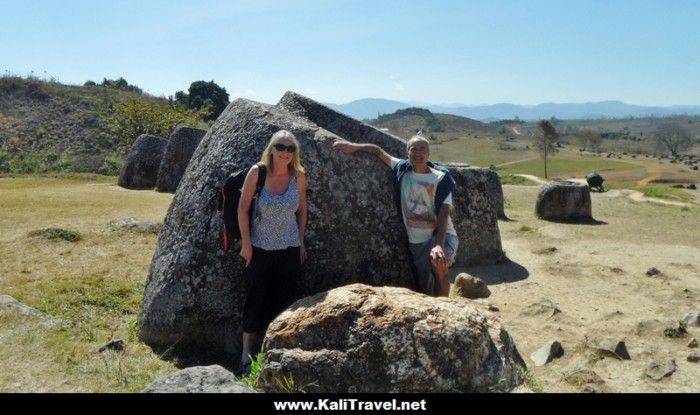
Scooter hire in Phonsavan is simple and cheap, a great way of getting to Plain of Jars and must-see places across the Xiangkhoang Plateau.
Jar Site 1
We drive off to see Plain of Jars, a UNESCO World Heritage Site, and one of the world’s greatest enigmas is just 8 km south of town; three separate archaeological sites date to the Iron Age, Site 1 being the largest with 338 sandstone mystery jars scattered over 28 hectares of grassy burial ground. The megalithic funerary urns are eroded by time, and many are broken or damaged, some are still covered with grave marker discs, remnants of a long-lost civilization.
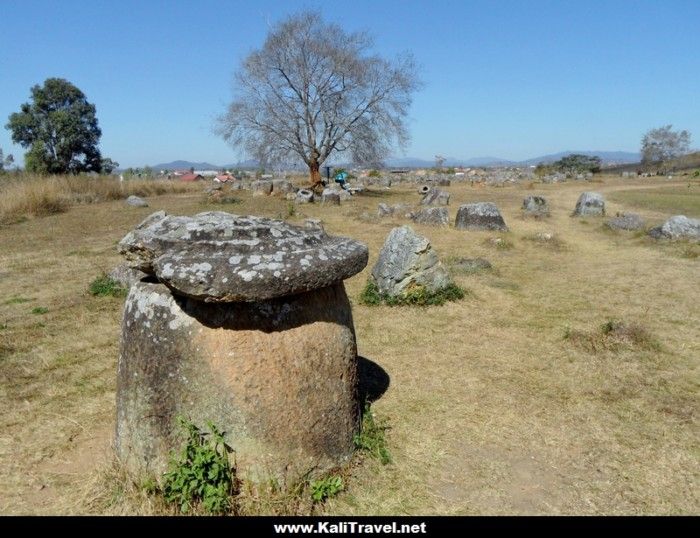
Plain of Jars has been a strategic military position over the centuries too, particularly in the Second Indochina War when the zone was carpet-bombed by the US.
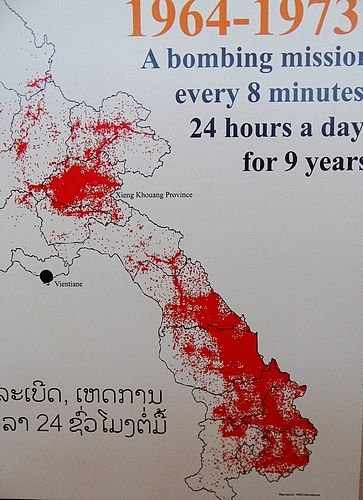
In fact, this is the heaviest bombed region in the heaviest bombed country in the world… a sobering tally of one bomb every eight minutes, around-the-clock, 365 days a year for nine years.
The visitors centre has information panels showing interesting old photographs, and explains what’s known about the mysterious prehistoric jars, as well as war history over the ages.
Cluster munitions dropped from planes dispersed bombies over the land, causing massive UXB contamination – four decades after the conflict ended, only one percent of the millions of unexploded bomblets have been deactivated.
A phrase to remember “keep on the beaten track” takes on a whole new meaning in northeastern Laos.
A lone Buddha statue sits at a little altar in a cave at the base of a limestone karst rock where the Laos Panthet command took shelter during air raids.
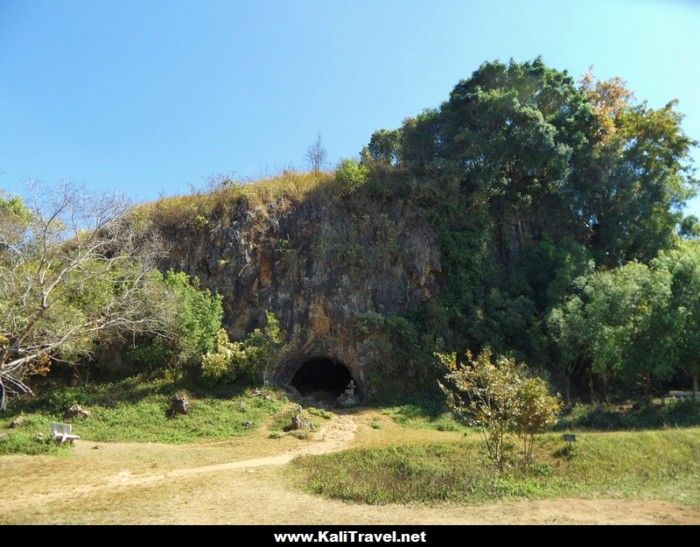
A track leads to the top of the rise where anti-aircraft guns sat in wait. Strange to imagine this place has such a turbulent and sinister history, when the views are so peaceful. It’s a warm sunny day with a clear blue sky, perfect for walking over the meadows (the carefully delimited ones which have been cleared of mines), wondering at secrets kept by the primeval jars which have stood witness for 2,500 years.
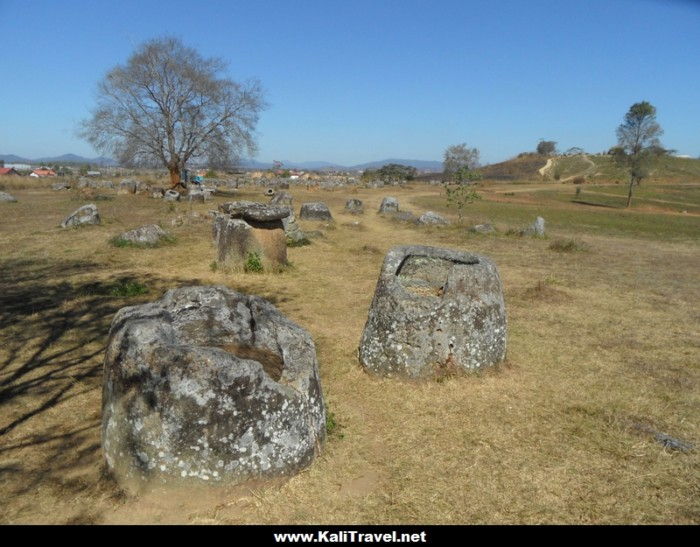
Ban Napia Village
The Spoon Village is further south, back on route D1 and past the signs to Jar Site 2, a turning leaves the plain through sectors of glittering pink minerals, waste from copper-gold mines maybe -I quash the urge to investigate, wary of unearthed bombs. Ban Napia is a clutch of houses either side of an uphill lane traversing a valley, wooden homesteads built on stilts with gardens backed by rolling fields of potential farming land, almost 30 km from Phonsavan.
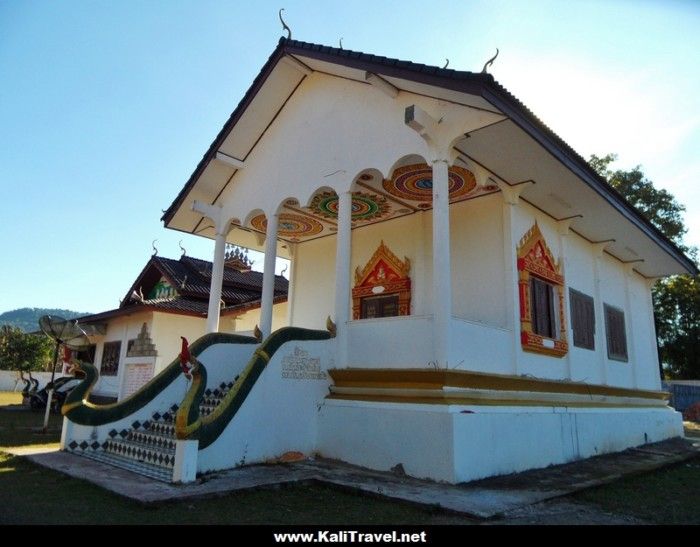
There’s a temple monastery in the village, one of few in the region, so many were wiped-out like everything else. The adjacent chalet has a ‘fence’ made of missiles (hopefully deactivated)! Next door there’s a weaving centre, a workshop where ladies deftly craft fabrics over traditional looms. Juan wanders off while I sit with an old woman who’s making bottle openers from shrapnel in her backyard. It’s a bit surreal.
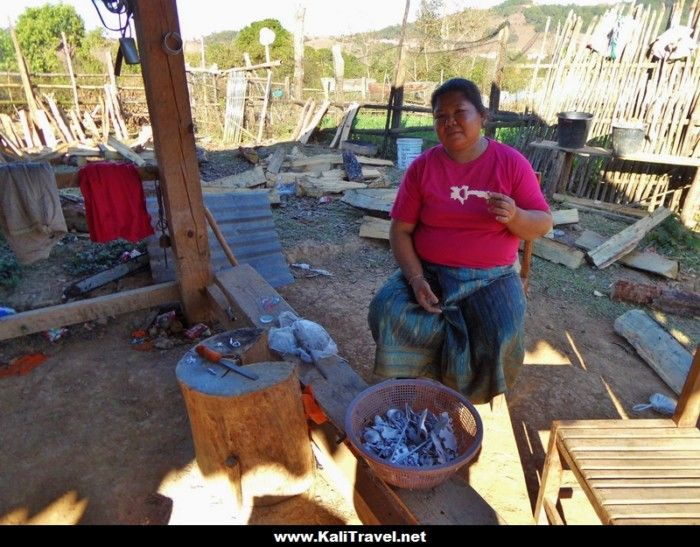
Making spoons from UXO in Laos
We’re invited to watch Lao spoon-makers working at home. These people are pleasant and friendly, it’s not just a touristy front -we don’t buy anything, they’re not selling to us; the family are making aluminum spoons for restaurants and markets, locally and across Laos…they’re made of fallen bombs.
I don’t know the ins and outs of wars, the ‘men’ behind the decisions, and can’t even imagine the anguish, but I can see that these people are hospitable although we don’t speak any common language, that their lands and heritage have been ruined, and here we are, big white strangers, ‘affluent’ foreigners, and they don’t know or care whether we are from the US, Europe or Mars.
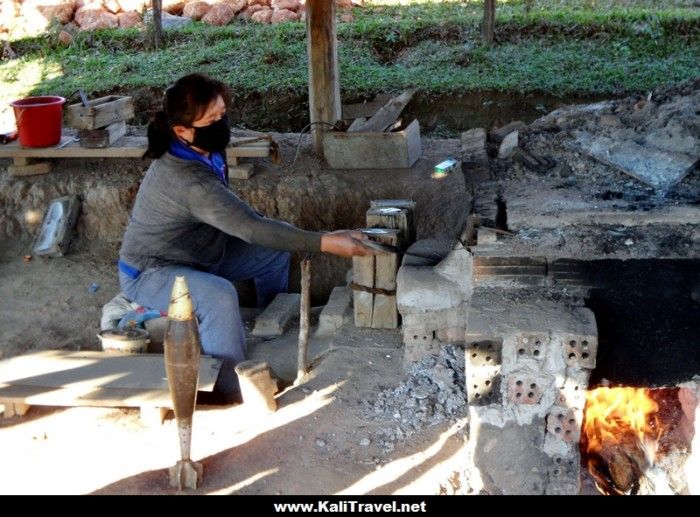
A teenager takes us over to the open-sided shed where his father and mother stop work to greet us. The kid stocks the rudimentary kiln with firewood, his mother puts aluminum scraps into the crucible, and when molten she ladles the runny metal into a rudimentary mold tied together with a strip of cloth.
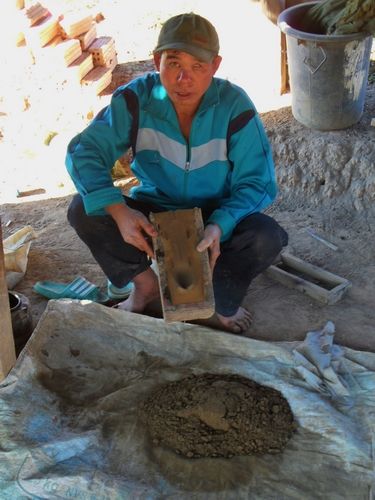
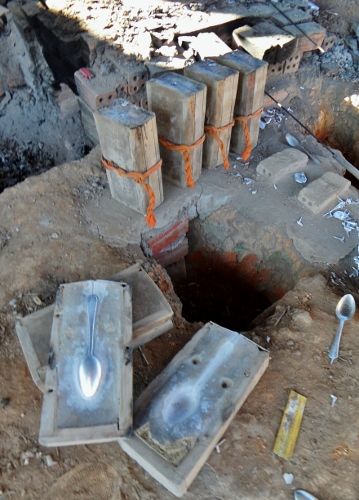
Dad is painstakingly making the cast molds by hand, book-sized wooden boxes filled with a clay-like mixture of dried ash and water; he presses a spoon into the middle to leave the shape. I am ashamed by my absolute lack of Lao language, I don’t understand their names, just the goodhearted openness, and their drive to make a livelihood after a conflict which leaves untenable farming land littered with unexploded ordnance. The shiny spoons lay cooling on the fence.
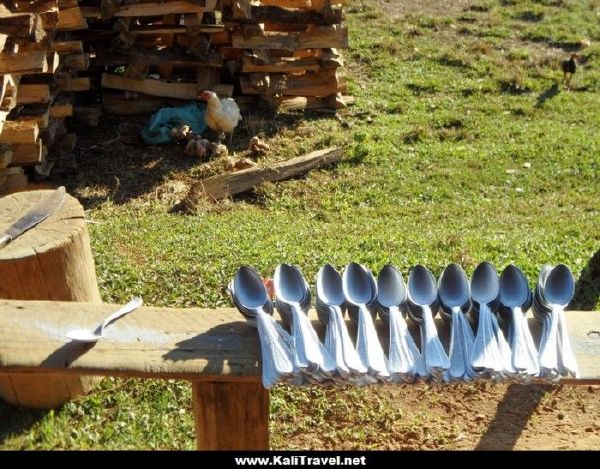
Someone came up with this bright idea in the poverty stricken post war “What do we have apart from bomb riddled land?” “Well, we have millions of UXO, there must be some use we can make of the metal” and someone thought about making the spoons, everyone needs a spoon to eat!
The idea caught on, spoons were sold to noodle shops where the influx of labourers building new Phonsavan town ate, and to restaurants when things calmed down and the travellers returned to see the ‘jars’, and lately to tourist markets in Luang Prabang and Vientianne, the capital of Laos. The youth shows us a defused rocket cased in aluminum -the family buys materials from a legal supplier, it is strictly prohibited to go out and look for bombs, as so many locals have been killed or maimed.
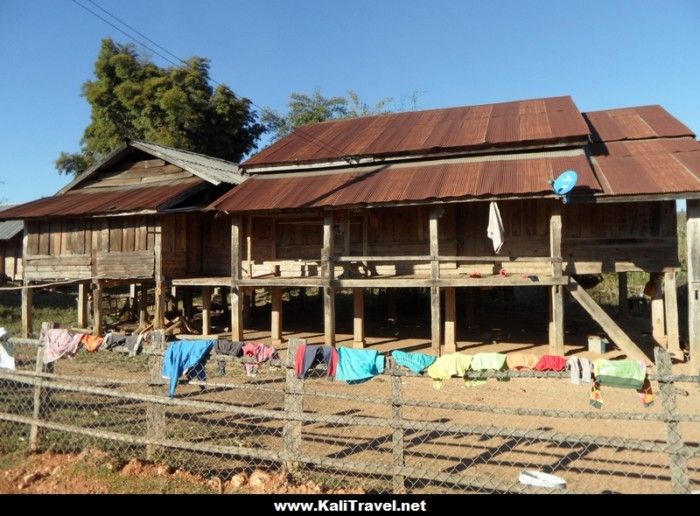
On the road back to Phonsavan we pull over and watch some cows grazing… weird to think these grasslands have been deforested by Agent Orange, and the fish ponds are water-filled craters. I tread carefully, staying on the well-worn visible tracks down to the lake and wave at a man fishing on an inner tube. On the ride home, I am gob-smacked to see a couple in a field with a metal detector!
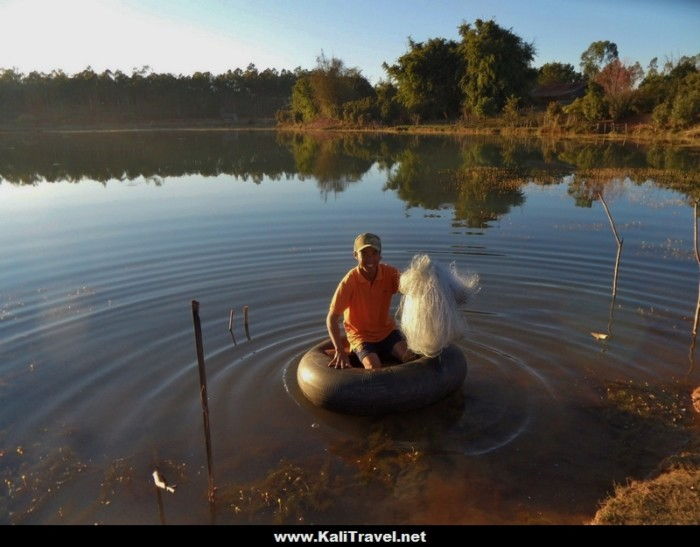
Phonsavan’s traditional indoor food market (next to the bus and minivan terminals) is full of fresh produce and bakery stalls, so I fill a bag with fruit and sweet pastries to eat on the upcoming ride to Sam Neua, and Vieng Xai, the ‘victorious’ cave city. Meanwhile, Main Street has lots of pocket-friendly restaurants, the photo cards making it simple to order dinner tonight; dishes of home-cooked noodle based or rice Lao cuisine, and even fried eggs and bread!
Related Posts on Visiting Laos
Here are more posts on our travels through Laos, this incredibly interesting but little-known land in the heart of South East Asia.
North Thailand-Laos border crossing for the Mekong Slow Boat
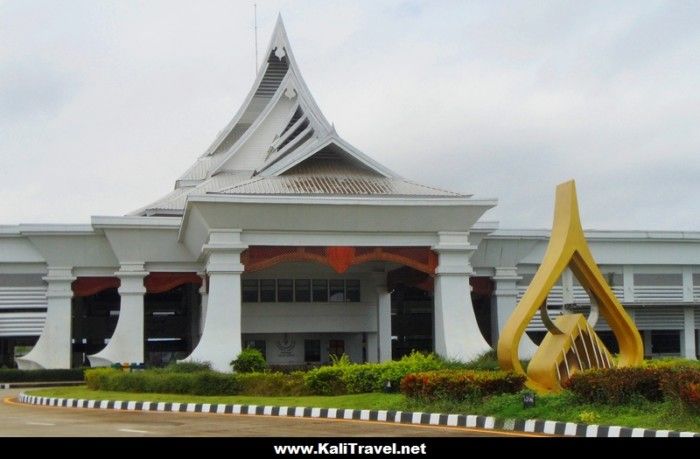
How to cross the North Thailand-Laos border at the 4th Mekong Friendship Bridge, and on to Huay Xai to get the 2-day Slow Boat down the Mekong River.
Sounds complicated? Not at all, see how we did it…
2 day Mekong slow boat from Huay Xai
Discovering Laos – Huay Xai and a 2 day slow boat down the Mekong River to Luang Prabang.
Huay Xai is a small river town in the remote Bokeo province of northern Laos…
3 Days in Luang Prabang UNESCO World Heritage City
Luang Prabang is a UNESCO World Heritage landmark famous for its Buddhist sites and French Colonial mansions.
One of the largest cities in Laos, it has a small-town feeling and looks just like a period film…
Luang Prabang – Sites unvisited by tourists
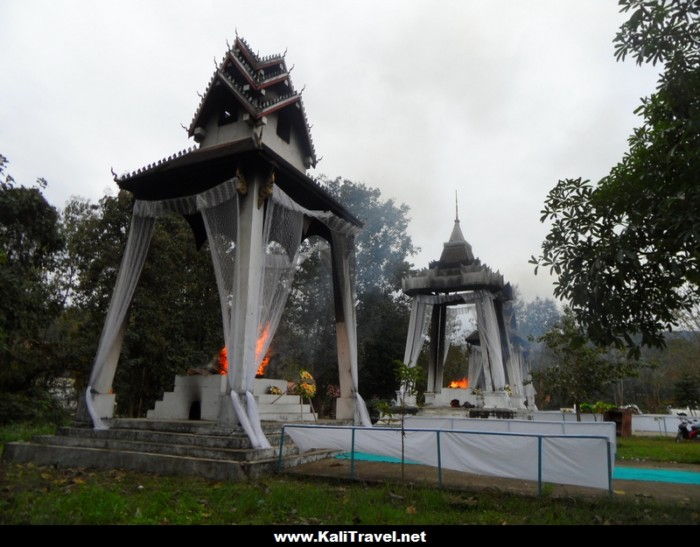
Luang Prabang – unvisited places and sites not yet discovered by tourists.
Luang Prabang unvisited. Behind the genteel glamour of colonial Luang Prabang there’s a different world waiting to be discovered…
Luang Prabang – Alms Ceremony and Kuansi Falls
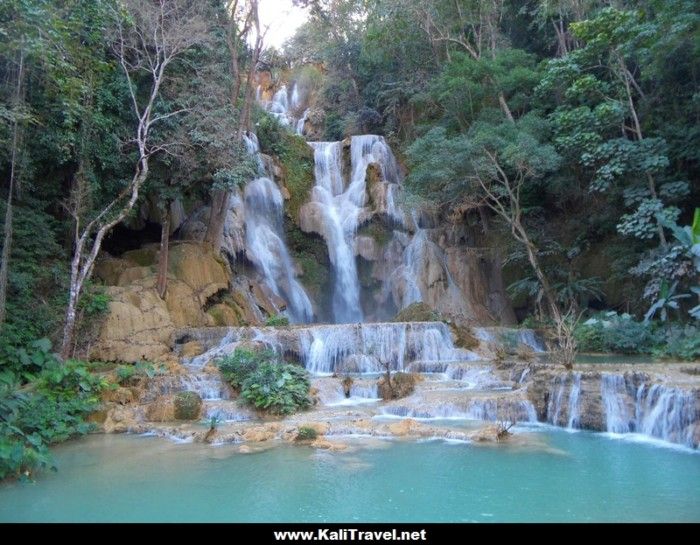
Watching the Dawn Alms Ceremony and an afternoon at Kuansi Falls, on the last of our 3 day adventure in Luang Prabang.
The last day in Luang Prabang is memorable…
1 day Guide to Plain of Jars and Ban Napia, Phonsavan

1 day guide to visiting the Plain of Jars and Ban Napia ‘spoon village’ near Phonsavan in Northeast Laos.
The private minibus ticket is not much dearer than getting a standard bus which covers the route from Luang Prabang to Phonsavan….
1 day visit to Vieng Xai Cave City
How to get to Vieng Xai – a fascinating 1 day visit to the secret Cave City in remote Northeast Laos.
The minibus leaves Phonsavan and the mysterious Plain of Jars behind for the tortuous road trip to Sam Neua…
To read more World Trip adventures CLICK HERE
Discover the World with ![]() the blog with a focus on independent budget travel.
the blog with a focus on independent budget travel.




